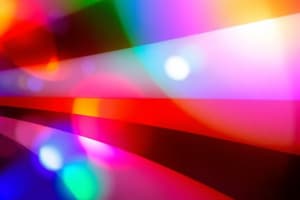Podcast
Questions and Answers
What type of cells in our eyes stimulate when they receive light?
What type of cells in our eyes stimulate when they receive light?
- Cones and rods (correct)
- Nerve cells
- Muscle cells
- Skin cells
What is the range of wavelengths in the visible spectrum?
What is the range of wavelengths in the visible spectrum?
- 390 to 750 nanometers (correct)
- 300 to 800 nanometers
- 500 to 900 nanometers
- 400 to 700 nanometers
What is the result of combining all light colors?
What is the result of combining all light colors?
- Brown
- Black
- White (correct)
- Gray
What is the primary color that is mixed with a secondary color to create a tertiary color?
What is the primary color that is mixed with a secondary color to create a tertiary color?
What is the term for the combination of hue and luminosity?
What is the term for the combination of hue and luminosity?
What is the result of combining all pigment colors?
What is the result of combining all pigment colors?
What type of color harmony is created when a primary color is mixed with its secondary complementary color?
What type of color harmony is created when a primary color is mixed with its secondary complementary color?
What artistic movement is known for its use of color harmonies and complementary colors?
What artistic movement is known for its use of color harmonies and complementary colors?
Flashcards are hidden until you start studying
Study Notes
Color Perception
- Color is a perception created by our brain when it receives signals from our eyes.
- Our eyes have receptor cells called cones and rods that stimulate when they receive light.
Light and Spectroscopy
- Light is formed by different wavelengths, which create the visible spectrum.
- The visible spectrum was discovered by Newton in 1655 when he passed a small beam of light through a prism.
- The visible spectrum ranges from 390 to 750 nanometers, while longer and shorter wavelengths are invisible to our eyes.
Color Theory
- There are two types of colors: light colors and pigment colors.
- Light colors are created through additive mixing and have three primaries: red, green, and blue (RGB).
- When all light colors are combined, white is produced, and when all are absent, black is produced.
Pigment Colors
- Pigment colors are created through subtractive synthesis and have three primaries: cyan, magenta, and yellow.
- When all pigment colors are combined, black is produced, and when all are absent, white is produced.
Color Harmonies
- When two primary colors are mixed, secondary colors are created.
- When a primary color is mixed with a secondary color, tertiary colors are created.
- A secondary color forms with its primary complementary color, which creates high contrast.
Artistic Applications
- Artists have used color harmonies and complementary colors throughout history, such as the Impressionist movement in France.
- Famous artists like Vincent van Gogh, Henri Matisse, and Fernando Zóbel have utilized color theory in their works.
Color Properties
- Hue refers to the color itself (e.g., blue, green, yellow).
- Saturation refers to the intensity or purity of the color.
- Luminosity refers to the brightness or darkness of the color.
- Tone refers to the combination of hue and luminosity.
- Shade refers to the darker version of a color, and tint refers to the lighter version.
Color Perception
- Our brain creates color perception from signals received from our eyes.
- Eyes have receptor cells (cones and rods) that stimulate when receiving light.
Light and Spectroscopy
- Different wavelengths of light form the visible spectrum.
- Newton discovered the visible spectrum in 1655 by passing a small beam of light through a prism.
- Visible spectrum ranges from 390 to 750 nanometers, while longer and shorter wavelengths are invisible.
Color Theory
- There are two types of colors: light colors (created through additive mixing) and pigment colors (created through subtractive synthesis).
- Light colors have three primaries: red, green, and blue (RGB).
- Combining all light colors produces white, while absenting all light colors produces black.
Pigment Colors
- Pigment colors have three primaries: cyan, magenta, and yellow.
- Combining all pigment colors produces black, while absenting all pigment colors produces white.
Color Harmonies
- Mixing two primary colors creates secondary colors.
- Mixing a primary color with a secondary color creates tertiary colors.
- Secondary color forms with its primary complementary color, creating high contrast.
Artistic Applications
- Artists have used color harmonies and complementary colors throughout history, including the Impressionist movement in France.
- Famous artists like Vincent van Gogh, Henri Matisse, and Fernando Zóbel have utilized color theory in their works.
Color Properties
- Hue refers to the color itself (e.g., blue, green, yellow).
- Saturation refers to the intensity or purity of the color.
- Luminosity refers to the brightness or darkness of the color.
- Tone refers to the combination of hue and luminosity.
- Shade refers to the darker version of a color, and tint refers to the lighter version.
Studying That Suits You
Use AI to generate personalized quizzes and flashcards to suit your learning preferences.




